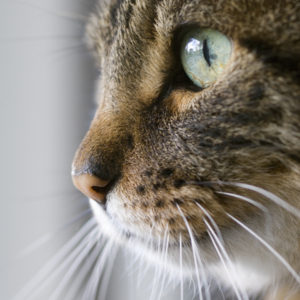Cats can become stressed, which can affect their health and interactions with you. It’s important to know more about the nature and behavior of cats so you can do your best to keep your cat calm and happy.
Understanding Your Cat’s Behavior
You probably already know that your cat is most comfortable with the familiar, and needs time to adjust to things, people, or places that are unfamiliar. When you bring your cat to visit the veterinarian, it is often difficult for her because the carrier, car, and the veterinary hospital are usually unfamiliar places and experiences.
Here are a few tips from our feline veterinarians:
- Respect your cat’s need for time to become familiar with new situations, people, and places.
- Leave the cat carrier out and open in your home so your cat can become familiar with it.
- Consider taking your cat on short trips in the car so she can become familiar with it and hopefully learn that a car visit does not mean you are taking her to the veterinarian’s office.
- Give your cat rewards to encourage positive behavior. For example, if your cat is sitting calmly in or near a carrier, give her a treat.
Your cat perceives the world through her senses. We’ve broken down ways to help keep your cat calm corresponding to the way your cat experiences her environment.

Smell
Your cat’s sense of smell is far superior to yours. It plays an important role in communication, social behavior, sexual activity, and food appreciation. Cats mark their scent by rubbing their face and body on objects and people, which deposits natural pheromones to establish boundaries within which they feel safe and secure. The scent of dogs, unfamiliar people, and the scent marking of another cat – even rubbing – can be frightening for your cat. To help your cat remain calm:
- Avoid cleaning your cat’s scent off areas and items that are hers (her bed, cat tree, and carrier to name a few).
- Consider using a synthetic facial pheromone like Feliway®, which can mimic your cat’s natural pheromones and provide a calming effect in a stressful or unfamiliar situation, like when you use her carrier, or when your cat is going to be around unfamiliar people or animals.
Hearing
Your cat’s hearing is approximately four times more sensitive than yours (65 kHz in cats vs 20 kHz in humans), and your cat hears higher frequencies than you, including ultrasound. However, she cannot localize sounds very well and because her sense of hearing is so sensitive, she perceives loud noises when we think we are talking in a normal voice. The noise of other cats, other animals, and strange people often startles cats. To help keep your cat calm:
- Try to keep the noises low around your cat, especially when she may be getting stressed due to an unfamiliar environment or person.
- Help dampen noise when she is in her carrier by using a towel to cover the carrier.
- Play soothing music in your home if she is becoming agitated.
- Remember to use a low, soothing voice when talking to your cat to help keep her calm.

Touch
Cats are also very sensitive to touch and use their whiskers to feel their environment. Did you know that some cats experience “whisker stress” and do not like pressure on their whiskers while they eat or drink? When aroused, your cat can be very sensitized, even to gentle petting or stroking. To help keep your cat calm:
- Pay attention to your cat’s body language. If she walks away from you, don’t chase her or try to engage. Let her come to you when she is ready.
- Most cats prefer to be touched on the head and neck. Avoid petting in other areas.
- Your cat may lose patience when you pet her for extended periods of time. Avoid reaching that tipping point by reading the subtle cues in your cat’s body language. Your cat will go very still with only the tip of the tail twitching. Her ears might be slightly lowered and to the sides and sometimes her back will ripple a bit.
- If you think your cat may be experiencing “whisker stress,” switch to wide, shallow bowls or plates for your cat’s water and food.
- Reward your cat when she does well with new people by petting her or with gentle handling.
Sight
Your cat can see well in dim light, has some color vision, and is very sensitive to movement. Rapid movements, especially if unanticipated, can heighten her responses and lead her to be more reactive. To help keep your cat calm:
- Make sure your movements around her are slow and provide distractions such as treats or toys. Usually slow is fast, and fast is slow with cats.
- Refrain from looming over your cat, since it makes you appear larger and potentially threatening. Crouch down and let your cat come to you.
- Do not insist on interacting with your cat if she is not interested.
- If your cat is in her carrier, you can cover it with a towel to create a visual barrier and help her feel a bit safer.
- Make sure your cat has a place in your house where she can retreat and also allows for some visual privacy, like a tall-sided or igloo cat bed and cardboard boxes. This allows your cat to “hide” and feel like she’s in control.

